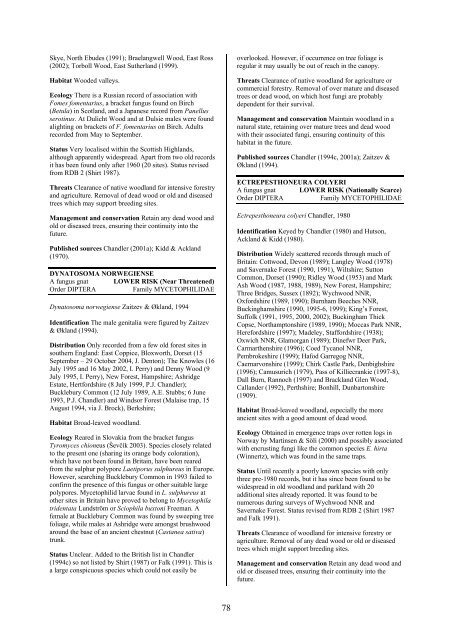Part 2: Nematocera and Aschiza not dealt with by Falk (1991) - JNCC
Part 2: Nematocera and Aschiza not dealt with by Falk (1991) - JNCC
Part 2: Nematocera and Aschiza not dealt with by Falk (1991) - JNCC
You also want an ePaper? Increase the reach of your titles
YUMPU automatically turns print PDFs into web optimized ePapers that Google loves.
Skye, North Ebudes (<strong>1991</strong>); Braelangwell Wood, East Ross<br />
(2002); Torboll Wood, East Sutherl<strong>and</strong> (1999).<br />
Habitat Wooded valleys.<br />
Ecology There is a Russian record of association <strong>with</strong><br />
Fomes fomentarius, a bracket fungus found on Birch<br />
(Betula) in Scotl<strong>and</strong>, <strong>and</strong> a Japanese record from Panellus<br />
serotinus. At Dulicht Wood <strong>and</strong> at Dulsie males were found<br />
alighting on brackets of F. fomentarius on Birch. Adults<br />
recorded from May to September.<br />
Status Very localised <strong>with</strong>in the Scottish Highl<strong>and</strong>s,<br />
although apparently widespread. Apart from two old records<br />
it has been found only after 1960 (20 sites). Status revised<br />
from RDB 2 (Shirt 1987).<br />
Threats Clearance of native woodl<strong>and</strong> for intensive forestry<br />
<strong>and</strong> agriculture. Removal of dead wood or old <strong>and</strong> diseased<br />
trees which may support breeding sites.<br />
Management <strong>and</strong> conservation Retain any dead wood <strong>and</strong><br />
old or diseased trees, ensuring their continuity into the<br />
future.<br />
Published sources Ch<strong>and</strong>ler (2001a); Kidd & Ackl<strong>and</strong><br />
(1970).<br />
DYNATOSOMA NORWEGIENSE<br />
A fungus gnat LOWER RISK (Near Threatened)<br />
Order DIPTERA<br />
Family MYCETOPHILIDAE<br />
Dynatosoma norwegiense Zaitzev & Økl<strong>and</strong>, 1994<br />
Identification The male genitalia were figured <strong>by</strong> Zaitzev<br />
& Økl<strong>and</strong> (1994).<br />
Distribution Only recorded from a few old forest sites in<br />
southern Engl<strong>and</strong>: East Coppice, Bloxworth, Dorset (15<br />
September – 29 October 2004, J. Denton); The Knowles (16<br />
July 1995 <strong>and</strong> 16 May 2002, I. Perry) <strong>and</strong> Denny Wood (9<br />
July 1995, I. Perry), New Forest, Hampshire; Ashridge<br />
Estate, Hertfordshire (8 July 1999, P.J. Ch<strong>and</strong>ler);<br />
Bucklebury Common (12 July 1989, A.E. Stubbs; 6 June<br />
1993, P.J. Ch<strong>and</strong>ler) <strong>and</strong> Windsor Forest (Malaise trap, 15<br />
August 1994, via J. Brock), Berkshire;<br />
Habitat Broad-leaved woodl<strong>and</strong>.<br />
Ecology Reared in Slovakia from the bracket fungus<br />
Tyromyces chioneus (Ševčík 2003). Species closely related<br />
to the present one (sharing its orange body coloration),<br />
which have <strong>not</strong> been found in Britain, have been reared<br />
from the sulphur polypore Laetiporus sulphureus in Europe.<br />
However, searching Bucklebury Common in 1993 failed to<br />
confirm the presence of this fungus or other suitable large<br />
polypores. Mycetophilid larvae found in L. sulphureus at<br />
other sites in Britain have proved to belong to Mycetophila<br />
tridentata Lundström or Sciophila buxtoni Freeman. A<br />
female at Bucklebury Common was found <strong>by</strong> sweeping tree<br />
foliage, while males at Ashridge were amongst brushwood<br />
around the base of an ancient chestnut (Castanea sativa)<br />
trunk.<br />
Status Unclear. Added to the British list in Ch<strong>and</strong>ler<br />
(1994c) so <strong>not</strong> listed <strong>by</strong> Shirt (1987) or <strong>Falk</strong> (<strong>1991</strong>). This is<br />
a large conspicuous species which could <strong>not</strong> easily be<br />
overlooked. However, if occurrence on tree foliage is<br />
regular it may usually be out of reach in the canopy.<br />
Threats Clearance of native woodl<strong>and</strong> for agriculture or<br />
commercial forestry. Removal of over mature <strong>and</strong> diseased<br />
trees or dead wood, on which host fungi are probably<br />
dependent for their survival.<br />
Management <strong>and</strong> conservation Maintain woodl<strong>and</strong> in a<br />
natural state, retaining over mature trees <strong>and</strong> dead wood<br />
<strong>with</strong> their associated fungi, ensuring continuity of this<br />
habitat in the future.<br />
Published sources Ch<strong>and</strong>ler (1994c, 2001a); Zaitzev &<br />
Økl<strong>and</strong> (1994).<br />
ECTREPESTHONEURA COLYERI<br />
A fungus gnat LOWER RISK (Nationally Scarce)<br />
Order DIPTERA<br />
Family MYCETOPHILIDAE<br />
Ectrepesthoneura colyeri Ch<strong>and</strong>ler, 1980<br />
Identification Keyed <strong>by</strong> Ch<strong>and</strong>ler (1980) <strong>and</strong> Hutson,<br />
Ackl<strong>and</strong> & Kidd (1980).<br />
Distribution Widely scattered records through much of<br />
Britain: Cottwood, Devon (1989); Langley Wood (1978)<br />
<strong>and</strong> Savernake Forest (1990, <strong>1991</strong>), Wiltshire; Sutton<br />
Common, Dorset (1990); Ridley Wood (1953) <strong>and</strong> Mark<br />
Ash Wood (1987, 1988, 1989), New Forest, Hampshire;<br />
Three Bridges, Sussex (1892); Wychwood NNR,<br />
Oxfordshire (1989, 1990); Burnham Beeches NNR,<br />
Buckinghamshire (1990, 1995-6, 1999); King’s Forest,<br />
Suffolk (<strong>1991</strong>, 1995, 2000, 2002); Buckingham Thick<br />
Copse, Northamptonshire (1989, 1990); Moccas Park NNR,<br />
Herefordshire (1997); Madeley, Staffordshire (1938);<br />
Oxwich NNR, Glamorgan (1989); Dinefwr Deer Park,<br />
Carmarthenshire (1996); Coed Tycanol NNR,<br />
Pembrokeshire (1999); Hafod Garregog NNR,<br />
Caernarvonshire (1999); Chirk Castle Park, Denbighshire<br />
(1996); Camusurich (1979), Pass of Killiecrankie (1997-8),<br />
Dall Burn, Rannoch (1997) <strong>and</strong> Brackl<strong>and</strong> Glen Wood,<br />
Call<strong>and</strong>er (1992), Perthshire; Bonhill, Dunbartonshire<br />
(1909).<br />
Habitat Broad-leaved woodl<strong>and</strong>, especially the more<br />
ancient sites <strong>with</strong> a good amount of dead wood.<br />
Ecology Obtained in emergence traps over rotten logs in<br />
Norway <strong>by</strong> Martinsen & Söli (2000) <strong>and</strong> possibly associated<br />
<strong>with</strong> encrusting fungi like the common species E. hirta<br />
(Winnertz), which was found in the same traps.<br />
Status Until recently a poorly known species <strong>with</strong> only<br />
three pre-1980 records, but it has since been found to be<br />
widespread in old woodl<strong>and</strong> <strong>and</strong> parkl<strong>and</strong> <strong>with</strong> 20<br />
additional sites already reported. It was found to be<br />
numerous during surveys of Wychwood NNR <strong>and</strong><br />
Savernake Forest. Status revised from RDB 2 (Shirt 1987<br />
<strong>and</strong> <strong>Falk</strong> <strong>1991</strong>).<br />
Threats Clearance of woodl<strong>and</strong> for intensive forestry or<br />
agriculture. Removal of any dead wood or old or diseased<br />
trees which might support breeding sites.<br />
Management <strong>and</strong> conservation Retain any dead wood <strong>and</strong><br />
old or diseased trees, ensuring their continuity into the<br />
future.<br />
78
















